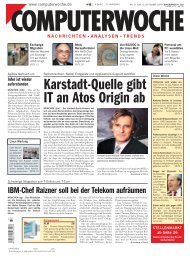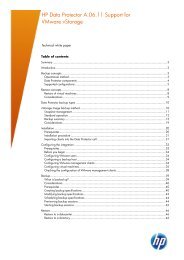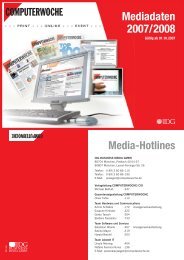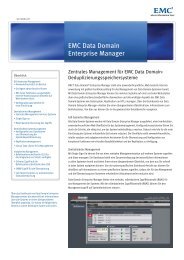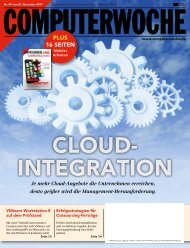The HP Business Intelligence Maturity Model: Describing the BI ...
The HP Business Intelligence Maturity Model: Describing the BI ...
The HP Business Intelligence Maturity Model: Describing the BI ...
You also want an ePaper? Increase the reach of your titles
YUMPU automatically turns print PDFs into web optimized ePapers that Google loves.
<strong>BI</strong> <strong>Maturity</strong> <strong>Model</strong><br />
<strong>Business</strong> Enablement<br />
Creating strategic agility<br />
and differentiation<br />
Foresight<br />
Fostering business innovation<br />
and people productivity<br />
Knowledge<br />
Integrating performance<br />
management and intelligence<br />
Insight<br />
Measuring and monitoring<br />
<strong>the</strong> business<br />
Information<br />
Running <strong>the</strong> business<br />
Facts and data<br />
Stage 1<br />
Operation<br />
Project<br />
Activity<br />
Ad Hoc<br />
Solutions<br />
A winning formula for <strong>BI</strong> success<br />
Stage 2<br />
Improvement<br />
Project Project<br />
Mgmt. Mgmt.<br />
Localized<br />
Solutions<br />
For well over a decade, companies have invested in<br />
a variety of business and IT initiatives that strive to<br />
improve decision-making and intelligence capabilities.<br />
As a result, <strong>the</strong>y have a rich set of building blocks to<br />
leverage as <strong>the</strong>y work toward a more integrated, agile<br />
business intelligence environment. Understanding how<br />
to leverage <strong>the</strong>ir <strong>BI</strong> investments fully while evolving to<br />
<strong>the</strong> next level of maturity can, however, be difficult.<br />
A <strong>BI</strong> maturity model can be invaluable in this process<br />
as it outlines a path forward and helps companies<br />
work toward closer alignment of <strong>the</strong>ir business and<br />
IT organizations.<br />
<strong>HP</strong> has developed a <strong>BI</strong> <strong>Maturity</strong> <strong>Model</strong> as a<br />
context for describing <strong>the</strong> evolution of our clients’ <strong>BI</strong><br />
capabilities. <strong>The</strong> model is based on our experiences<br />
with clients across a wide range of industries. It<br />
represents a formula for success that is a function of<br />
three capabilities: business enablement, information<br />
technology, and strategy and program management.<br />
<strong>The</strong> business enablement dimension describes <strong>the</strong><br />
advancing nature of <strong>the</strong> types of business needs and<br />
problems that are solved with <strong>BI</strong> solutions.<br />
<strong>The</strong> information technology dimension describes<br />
<strong>the</strong> advancing nature of <strong>the</strong> information solutions a<br />
company adopts to serve a variety of business needs.<br />
Stage 3<br />
Alignment<br />
Program Program<br />
Mgmt. Mgmt. and and<br />
Governance Governance<br />
Shared<br />
Resources<br />
Stage 4<br />
Empowerment<br />
Portfolio<br />
Mgmt.<br />
Enterprise<br />
Operationalized<br />
Stage 5<br />
Transformation<br />
Service<br />
Mgmt.<br />
Enterprise<br />
Services<br />
Strategy Stra Strategy and<br />
Prog Program<br />
Mana Management<br />
Information<br />
Technology<br />
<strong>The</strong> strategy and program management dimension<br />
describes <strong>the</strong> advancing nature of management skill<br />
as a key enabler and catalyst for <strong>BI</strong> success.<br />
In this white paper, we look at <strong>the</strong> characteristics of<br />
companies in each stage of <strong>the</strong> <strong>BI</strong> journey across<br />
<strong>the</strong>se three dimensions. We also describe <strong>the</strong> steps<br />
companies must take to advance <strong>the</strong>ir capabilities<br />
from one level to <strong>the</strong> next.<br />
Stage 1: Running <strong>the</strong> business<br />
Many organizations are still in <strong>the</strong> early stages of<br />
making core <strong>BI</strong> investments. <strong>The</strong>se might include new<br />
companies that are just beginning to think about<br />
<strong>BI</strong>, but might also encompass organizations that<br />
have already been through several false starts with<br />
<strong>BI</strong> and are revisiting <strong>the</strong>ir basic <strong>BI</strong> strategy. This is<br />
<strong>the</strong> beginning stage in which frameworks are being<br />
laid and concepts are being formed, often at <strong>the</strong><br />
departmental or local level within an enterprise. In<br />
Stage 1, <strong>BI</strong> is necessary to pull in facts and data as<br />
needed to simply run <strong>the</strong> business.<br />
<strong>Business</strong> enablement in Stage 1: <strong>Business</strong> needs are<br />
focused on <strong>the</strong> enhancement of basic reporting and<br />
analysis capabilities, with spreadsheets often used<br />
as <strong>the</strong> <strong>BI</strong> tool of choice. <strong>BI</strong> consumers are mostly<br />
concentrated among executives and managers,<br />
with a small group of analysts or operations users<br />
3






